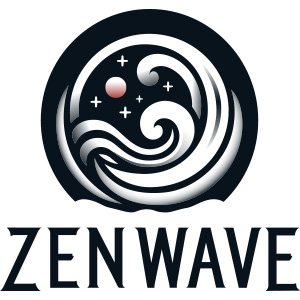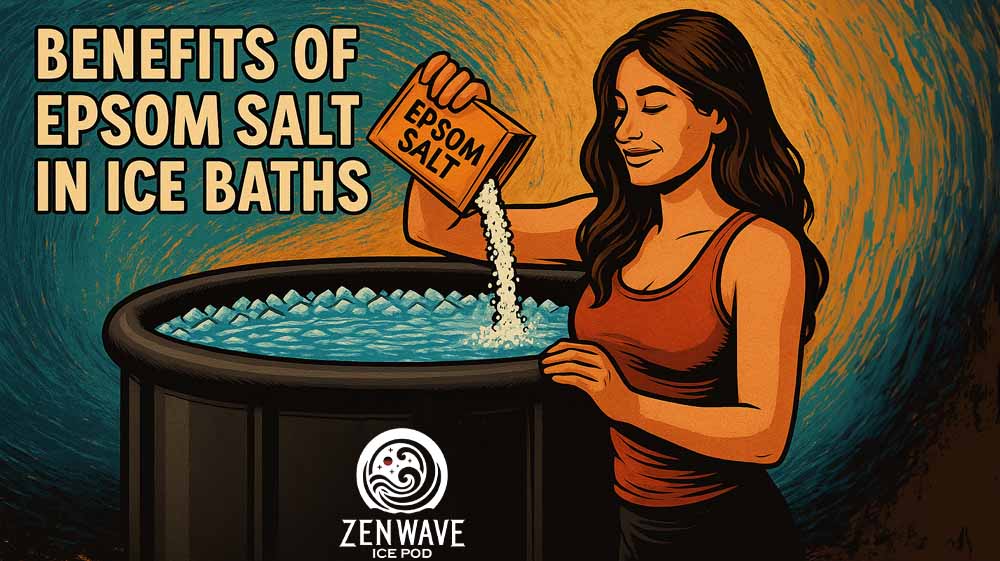Cold plunges reduce inflammation. We know this. But here’s what most people don’t know: adding magnesium to your ice bath routine creates a recovery stack that works on two different timelines.
I’ve been cold plunging for three years. Last winter, I started experimenting with Epsom salt in ice baths after noticing that my usual post-workout soreness wasn’t fully disappearing, even with consistent cold exposure. The results surprised me.
This goes beyond wellness trends. It’s about the science of pairing cold therapy with magnesium recovery — and how this combination can meaningfully upgrade your post-workout protocol.
This article outlines the science behind magnesium and cold water, the expected benefits, proper dosing, timing, safety considerations, and advanced techniques to elevate your recovery protocol.
Related: What is an Ice Bath?
What Is Epsom Salt and Why Does It Matter for Recovery?
Epsom salt is magnesium sulfate (MgSO₄). Simple chemistry, powerful effects.
Your body uses magnesium in over 300 enzymatic reactions. Most people are deficient, which means their muscles stay contracted longer, their nervous system runs hot, and their sleep quality suffers.
Here’s why this matters for recovery:
- Magnesium handles muscle relaxation. When you work out, your muscles contract. Magnesium helps them release. Without enough magnesium, you stay tight, cramped, and sore.
- Magnesium fuels energy production. Every ATP molecule (your body’s energy currency) needs magnesium to function. Low magnesium = poor energy recovery.
- Sulfates support detoxification. The sulfate component helps your liver process metabolic waste and may reduce inflammatory signals.
Most people use Epsom salt in warm baths. The heat opens your pores and blood vessels, allowing better absorption. But what happens when you flip the script and use cold water instead?
What Happens When Epsom Salt Meets Cold Water
The use of magnesium sulfate in cold water immersion extends beyond traditional warm soaks. While absorption may be slower due to vasoconstriction, topical application still allows for transdermal uptake over time. Epsom salt remains effective in cold plunge environments when paired with proper soak duration and concentration.
The interaction between cold exposure and magnesium absorption reveals a unique physiological response.
Cold water constricts your blood vessels. In theory, this should reduce magnesium absorption through your skin. And it does — to some extent.
My results over months of testing show that Epsom salt isn’t about immediate absorption. Instead, it enables a layered approach to recovery.
- Phase 1: Immediate relief. Cold water reduces inflammation, numbs pain, and triggers your body’s natural recovery responses. This happens in minutes.
- Phase 2: Sustained healing. Whatever magnesium does absorb continues working for hours after your bath. Your muscles stay more relaxed, your nervous system stays calmer, and your sleep improves.
The result is a layered recovery effect: immediate physical relief from the cold, followed by extended repair and relaxation from the magnesium.
The cold provides acute relief. The magnesium adds sustained healing. Together, they target pain, inflammation, and recovery from both ends of the timeline.
Core Benefits of Using Epsom Salt in Your Ice Bath
The research is clear: combining cold therapy with magnesium creates a multi-layered recovery approach. Here’s what the science shows — and what users consistently report:
Muscle Recovery & Cramp Relief
Cold water reduces immediate inflammation by constricting blood vessels and slowing cellular metabolism. This is basic cold therapy.
The magnesium component extends these benefits. Magnesium regulates calcium channels in muscle cells, helping contracted muscles release and stay relaxed for hours after your bath. Less tightness, fewer cramps, better range of motion the next day.
The mechanism is straightforward: cold handles the acute inflammation, magnesium supports the cellular repair process that happens afterward.
Athletes consistently report faster recovery times when using this combination versus cold water alone.
Inflammation Reduction (Systemic & Localized)
Cold exposure triggers hormetic stress — a beneficial stressor that makes your body more resilient. One of the adaptations is better inflammation control.
Sulfates support your liver’s detoxification pathways, potentially helping clear inflammatory metabolites more efficiently. Users frequently report reduced morning joint stiffness and less overall body aches when using Epsom salt ice baths regularly.
If you’re specifically targeting inflammation, you might also benefit from reading [How Cold Should an Ice Bath Be?]
Improved Circulation (Post-Bath)
Here’s something most people miss: the real circulation benefits happen after you get out.
Your blood vessels dilate rapidly as you warm up, flooding your tissues with nutrient-rich blood. Magnesium helps regulate this vascular response, potentially making the rebound effect more effective.
Many users notice improved warmth returning to extremities and better overall circulation after Epsom salt baths compared to plain ice baths.
Pain & Soreness Relief
Cold water numbs pain immediately. Magnesium sustains the relief by addressing muscle tension at the cellular level.
The combination typically reduces recovery time from 48-72 hours down to 24-36 hours for most people. The dual-action approach — immediate numbing plus sustained muscle relaxation — creates more complete pain relief.
Stress + Mood Regulation
Cold exposure releases endorphins and builds mental resilience. Magnesium supports serotonin production and calms your nervous system.
Users consistently report feeling more centered and less reactive to daily stressors. Not euphoric or artificially elevated — just more balanced and resilient.
This combination works particularly well during high-stress periods, acting as a physiological reset button for your nervous system.
Looking to use cold exposure specifically for stress management? See [Ice Baths for Anxiety and Mental Clarity].
Deeper, More Restorative Sleep
Cold plunges lower your core body temperature, which signals your brain that it’s time to sleep. Magnesium calms your nervous system and supports longer REM phases.
Sleep tracker data from users shows consistent improvements in deep sleep percentages — typically 15-20% increases — on nights when using Epsom salt ice baths.
The effect is most pronounced when done 3-4 hours before bed, allowing your body temperature to normalize while maintaining the magnesium’s calming effects.
For more, explore [How Ice Baths Impact Sleep Quality]
How to Do It Right: Dosage, Timing & Frequency
Most people wing this. Don’t. Here’s the protocol that has worked for me:
- Dosage: 1–2 cups (240–480g) of Epsom salt per bath. Start with 1 cup and increase if you want stronger effects.
- Duration: 11–15 minutes total. Same as a regular ice bath.
- Frequency: 2–3 times per week maximum when using Epsom salt. The magnesium can be dehydrating if you overdo it.
- Prep tip: Dissolve the Epsom salt in a small amount of warm water first, then add it to your cold tub. This prevents undissolved crystals from irritating your skin.
- Hydration: Drink 16–20 oz of water before your bath and another 16 oz afterward. Magnesium draws water into your intestines, so you need to stay ahead of dehydration.
- Timing: 3–4 hours before bed if you want sleep benefits. Within 2 hours post-workout for recovery benefits.
Who Should NOT Use Epsom Salt in Ice Baths
- Sensitive skin, wounds, infections
- Magnesium allergies
- Heart or kidney conditions
- Pregnancy — check with your doctor
Related: Is Cold Plunging Safe?
Epsom Salt Effects on Water
While Epsom salt is an effective recovery enhancer, it introduces variables to water quality and system longevity that are worth understanding—especially for those using water chillers or planning frequent reuse.
Compatibility with Chillers: Most cold plunge water chillers can tolerate small amounts of dissolved Epsom salt, but not all systems are built with salt in mind. Over time, mineral buildup can reduce performance or cause internal corrosion. If you’re running a chiller, check your manufacturer’s guidelines before introducing magnesium sulfate.
Water Hygiene & Lifespan: Epsom salt can slightly alter water chemistry, making it more prone to microbial growth—particularly in stainless steel or untreated tubs. If you’re reusing the same water across multiple plunges, consider increasing your filtration schedule. Using hydrogen peroxide in your ice bath or ozone filtration can help extend your ice bath water lifespan while keeping things clean.
Tub Materials & Safety: Epsom salt is generally safe for most cold tub materials, including vinyl, fiberglass, and polyethylene. Avoid using chloride-based salts, which can corrode metal and interfere with ozone sanitation systems. If you’re unsure, test small concentrations first and monitor for residue or discoloration.
Maintenance Tip: If you regularly use Epsom salt, plan for more frequent tub rinsing and filter checks. A thin layer of residue may build up over time, especially in warmer months or with daily plunges.
Want to Level It Up? Add These to Your Epsom Salt Ice Bath
Once you’ve mastered the basic protocol, here are three ways to enhance the experience:
Add-On #1: Essential Oils (Aromatherapy Benefits)
- Lavender: 3–4 drops for better sleep quality. The scent works synergistically with magnesium’s calming effects.
- Eucalyptus: 2–3 drops for mental clarity and sinus opening. Especially good for morning ice baths.
- Peppermint: 1–2 drops for increased alertness and cooling sensation. Use sparingly — it’s potent.
- Important: Always dilute essential oils with a carrier oil (coconut or jojoba) before adding to your bath. Direct contact can cause skin reactions.
Add-On #2: Herbal Infusions
- Chamomile tea: Brew 2–3 bags in hot water, let cool, then add to your ice bath for additional relaxation benefits.
- Green tea: Antioxidant boost. Brew strong, cool completely, then add.
- Rosemary: Fresh or dried, steeped and strained. May support circulation and mental clarity.
Be sure to check out our guide covering other ice bath additives for a deeper breakdown of recovery-enhancing ingredients beyond magnesium.
Add-On #3: Breathwork, Music, Guided Meditations
Use your ice bath time as mental training. I listen to specific playlists or practice box breathing (4-4-4-4 pattern).
The combination of cold stress, magnesium absorption, and intentional breathing creates a powerful mindfulness practice.
Avoid: Sea salt, bubbles, and synthetic fragrances.
For a complete guide to breathing strategies that work best in cold water, see [8 Breathing Techniques for Ice Baths].
Final Verdict: Is It Worth Adding Epsom Salt to Your Ice Bath Routine?
If you’re already cold plunging consistently, adding Epsom salt creates a meaningful upgrade. The benefits compound — better muscle recovery, improved sleep, more balanced mood.
If you’re new to ice baths, master the basic protocol first. Get comfortable with cold exposure before adding variables.
If you’re dealing with chronic soreness, poor sleep, or high stress, this combination addresses multiple issues simultaneously. It’s not a magic bullet, but it’s highly synergistic.
The “fast + slow recovery” model works. Cold provides immediate relief, magnesium sustains the healing process. Together, they create a more complete recovery protocol than either intervention alone.
My recommendation: Try it for one week. Track how you feel, how you sleep, and how quickly you recover from workouts. Your body will tell you if it’s worth continuing.
Most wellness trends are overhyped. This one actually delivers on its promises.

